Snapshot-Based Visible-Near Infrared Multispectral Imaging for Early Screening of Heat Injury during Growth of Chinese Cabbage
Abstract
1. Introduction
- Establish a Vis/NIR SMI system for spectral data (including hyper cubes) of Chinese cabbage under normal and heat stress conditions.
- Identify growth parameters of Chinese cabbage grown under different temperature levels and acquire their spectral and VIs (NDVI, RE/R, and PRI) information.
- Develop PLS-DA and LS-SVM models for distinguishing heat-stressed areas from Chinese cabbage leaves and compare their discriminant performance with obtained VIs to verify the developed model performance.
- Provide pixel-based chemical images of heat-stress distribution in Chinese cabbage leaves using the newly developed models with an increase in heat stress intensity.
2. Materials and Methods
2.1. Sample Preparation
2.2. Growth and Photosynthetic Parameters
2.3. Vis/NIR SMI System
2.4. VI Selection
2.5. Chemometric Models
2.6. Evaluation of Classification Models
2.7. Spectral Calibration
2.8. Visualization of Heat Stress
3. Results
3.1. Acquried Spectra
3.2. Discriminant Performance of VIs
3.3. Discriminant Performance of All Models
3.4. Heat Stress Visualization
4. Discussion
4.1. Spectral Analysis
4.2. Growth Parameter Analysis
4.3. Discriminant Performance Analysis
4.4. Heat Stress Visualization
5. Conclusions
Author Contributions
Funding
Institutional Review Board Statement
Informed Consent Statement
Conflicts of Interest
References
- Pachauri, R.K.; Meyer, L.A. Contribution of Working Groups I, II and III to the Fifth Assessment Report of the Intergovernmental Panel on Climate Change; IPCC: Geneva, Switzerland, 2014. [Google Scholar]
- Battisti, D.S.; Naylor, R.L. Historical Warnings of Future Food Insecurity with Unprecedented Seasonal Heat. Science 2009, 323, 240–244. [Google Scholar] [CrossRef] [PubMed]
- Lin, K.H.; Huang, H.C.; Lin, C.Y. Cloning, Expression and Physiological Analysis of Broccoli Catalase Gene and Chinese Cabbage Ascorbate Peroxidase Gene under Heat Stress. Plant Cell Rep. 2010, 29, 575–593. [Google Scholar] [CrossRef] [PubMed]
- Song, X.; Hu, J.; Wu, T.; Yang, Q.; Feng, X.; Lin, H.; Feng, S.; Cui, C.; Yu, Y.; Zhou, R.; et al. Comparative Analysis of Long Noncoding RNAs in Angiosperms and Characterization of Long Noncoding RNAs in Response to Heat Stress in Chinese Cabbage. Hortic. Res. 2021, 8, 48. [Google Scholar] [CrossRef] [PubMed]
- Lee, S.S.; Jung, W.Y.; Park, H.J.; Lee, A.; Kwon, S.-Y.; Kim, H.-S.; Cho, H.S. Genome-Wide Analysis of Alternative Splicing in An Inbred Cabbage (Brassica oleracea L.) Line ‘HO’ in Response to Heat Stress. Curr. Genom. 2017, 19, 12–20. [Google Scholar] [CrossRef]
- Ahmed, W.; Li, R.; Xia, Y.; Bai, G.; Siddique, K.H.M.; Zhang, H.; Zheng, Y.; Yang, X.; Guo, P. Comparative Analysis of MiRNA Expression Profiles between Heat-Tolerant and Heat-Sensitive Genotypes of Flowering Chinese Cabbage Under Heat Stress Using High-Throughput Sequencing. Genes 2020, 11, 264. [Google Scholar] [CrossRef] [PubMed]
- Yu, J.G.; Lee, G.H.; Lee, S.C.; Park, Y.D. Gene Expression and Phenotypic Analyses of Transgenic Chinese Cabbage Over-Expressing the Cold Tolerance Gene, BrCSR. Hortic. Environ. Biotechnol. 2014, 55, 415–422. [Google Scholar] [CrossRef]
- Yarra, R.; Xue, Y. Ectopic Expression of Nucleolar DEAD-Box RNA Helicase OsTOGR1 Confers Improved Heat Stress Tolerance in Transgenic Chinese Cabbage. Plant Cell Rep. 2020, 39, 1803–1814. [Google Scholar] [CrossRef]
- Park, H.J.; Jung, W.Y.; Lee, S.S.; Song, J.H.; Kwon, S.Y.; Kim, H.; Kim, C.; Ahn, J.C.; Cho, H.S. Use of Heat Stress Responsive Gene Expression Levels for Early Selection of Heat Tolerant Cabbage (Brassica oleracea L.). Int. J. Mol. Sci. 2013, 14, 11871–11894. [Google Scholar] [CrossRef]
- Chen, J.; Li, R.; Xia, Y.; Bai, G.; Guo, P.; Wang, Z.; Zhang, H.; Siddique, K.H.M. Development of EST-SSR Markers in Flowering Chinese Cabbage (Brassica campestris L. Ssp. Chinensis Var. Utilis Tsen et Lee) Based on de Novo Transcriptomic Assemblies. PLoS ONE 2017, 12, e0184736. [Google Scholar] [CrossRef]
- Seiki, S.; Norio, K.; Sumio, I.; Manabu, H. Effect of Low Temperature Pretreatment of Buds or Inflorescence on Isolated Microspore Culture in Brassica Rapa (Syn. B. Campestris). Breed. Sci. 2002, 52, 23–26. [Google Scholar] [CrossRef]
- Kramchote, S.; Nakano, K.; Kanlayanarat, S.; Ohashi, S.; Takizawa, K.; Bai, G. Rapid Determination of Cabbage Quality Using Visible and Near-Infrared Spectroscopy. LWT—Food Sci. Technol. 2014, 59, 695–700. [Google Scholar] [CrossRef]
- Nakajima, S.; Genkawa, T.; Miyamoto, A.; Ikehata, A. Useful Tissues in Cabbage Head for Freshness Evaluation with Visible and near Infrared Spectroscopy. Food Chem. 2021, 339, 128058. [Google Scholar] [CrossRef]
- Min, M.; Lee, W.S.; Kim, Y.H.; Bucklin, R.A. Nondestructive Detection of Nitrogen in Chinese Cabbage Leaves Using VIS-NIR Spectroscopy. HortScience 2006, 41, 162–166. [Google Scholar] [CrossRef]
- Liu, Q.; Chen, S.; Zhou, D.; Ding, C.; Wang, J.; Zhou, H.; Tu, K.; Pan, L.; Li, P. Nondestructive Detection of Weight Loss Rate, Surface Color, Vitamin c Content, and Firmness in Mini-Chinese Cabbage with Nanopackaging by Fourier Transform-near Infrared Spectroscopy. Foods 2021, 10, 2309. [Google Scholar] [CrossRef] [PubMed]
- Qin, J.; Chao, K.; Kim, M.S.; Lu, R.; Burks, T.F. Hyperspectral and Multispectral Imaging for Evaluating Food Safety and Quality. J. Food Eng. 2013, 118, 157–171. [Google Scholar] [CrossRef]
- Kim, G.; Lee, H.; Cho, B.-K.; Baek, I.; Kim, M.S. Quantitative Evaluation of Food-Waste Components in Organic Fertilizer Using Visible–Near-Infrared Hyperspectral Imaging. Appl. Sci. 2021, 11, 8201. [Google Scholar] [CrossRef]
- Kim, G.; Baek, I.; Stocker, M.D.; Smith, J.E.; Van Tassell, A.L.; Qin, J.; Chan, D.E.; Pachepsky, Y.; Kim, M.S. Hyperspectral Imaging from a Multipurpose Floating Platform to Estimate Chlorophyll-a Concentrations in Irrigation Pond Water. Remote Sens. 2020, 12, 2070. [Google Scholar] [CrossRef]
- Kim, G.; Lee, H.; Baek, I.; Cho, B.-K.; Kim, M.S. Quantitative Detection of Benzoyl Peroxide in Wheat Flour Using Line-Scan Short-Wave Infrared Hyperspectral Imaging. Sens. Actuators B Chem. 2022, 352, 130997. [Google Scholar] [CrossRef]
- Baek, I.; Kusumaningrum, D.; Kandpal, L.M.; Lohumi, S.; Mo, C.; Kim, M.S.; Cho, B.K. Rapid Measurement of Soybean Seed Viability Using Kernel-Based Multispectral Image Analysis. Sensors 2019, 19, 271. [Google Scholar] [CrossRef]
- Su, W.H.; Sun, D.W. Multispectral Imaging for Plant Food Quality Analysis and Visualization. Compr. Rev. Food Sci. Food Saf. 2018, 17, 220–239. [Google Scholar] [CrossRef]
- Irons, J.R.; Dwyer, J.L.; Barsi, J.A. The next Landsat Satellite: The Landsat Data Continuity Mission. Remote Sens. Environ. 2012, 122, 11–21. [Google Scholar] [CrossRef]
- Mouroulis, P.; Green, R.O.; Chrien, T.G. Design of Pushbroom Imaging Spectrometers for Optimum Recovery of Spectroscopic and Spatial Information. Appl. Opt. 2000, 39, 2210. [Google Scholar] [CrossRef] [PubMed]
- McClung, A.; Samudrala, S.; Torfeh, M.; Mansouree, M.; Arbabi, A. Snapshot Spectral Imaging with Parallel Metasystems. Sci. Adv. 2020, 6, eabc7646. [Google Scholar] [CrossRef] [PubMed]
- Hagen, N.; Kudenov, M.W. Review of Snapshot Spectral Imaging Technologies. Opt. Eng. 2013, 52, 090901. [Google Scholar] [CrossRef]
- Lowe, A.; Harrison, N.; French, A.P. Hyperspectral Image Analysis Techniques for the Detection and Classification of the Early Onset of Plant Disease and Stress. Plant Methods 2017, 13, 80. [Google Scholar] [CrossRef]
- Park, E.; Kim, Y.S.; Omari, M.K.; Suh, H.K.; Faqeerzada, M.A.; Kim, M.S.; Baek, I.; Cho, B.K. High-Throughput Phenotyping Approach for the Evaluation of Heat Stress in Korean Ginseng (Panax Ginseng Meyer) Using a Hyperspectral Reflectance Image. Sensors 2021, 21, 5634. [Google Scholar] [CrossRef]
- Chauchard, F.; Cogdill, R.; Roussel, S.; Roger, J.M.; Bellon-Maurel, V. Application of LS-SVM to Non-Linear Phenomena in NIR Spectroscopy: Development of a Robust and Portable Sensor for Acidity Prediction in Grapes. Chemom. Intell. Lab. Syst. 2004, 71, 141–150. [Google Scholar] [CrossRef]
- Pu, H.; Kamruzzaman, M.; Sun, D.W. Selection of Feature Wavelengths for Developing Multispectral Imaging Systems for Quality, Safety and Authenticity of Muscle Foods—A Review. Trends Food Sci. Technol. 2015, 45, 86–104. [Google Scholar] [CrossRef]
- Peters, A.J.; Walter-Shea, E.A.; Ji, L.; Viña, A.; Hayes, M.; Svoboda, M.D. Drought Monitoring with NDVI-Based Standardized Vegetation Index. Photogramm. Eng. Remote Sens. 2002, 68, 71–75. [Google Scholar]
- Garbulsky, M.F.; Peñuelas, J.; Gamon, J.; Inoue, Y.; Filella, I. The Photochemical Reflectance Index (PRI) and the Remote Sensing of Leaf, Canopy and Ecosystem Radiation Use Efficiencies. A Review and Meta-Analysis. Remote Sens. Environ. 2011, 115, 281–297. [Google Scholar] [CrossRef]
- Chang, J.; Shoshany, M. Red-Edge Ratio Normalized Vegetation Index for Remote Estimation of Green Biomass. In Proceedings of the 2016 IEEE International Geoscience and Remote Sensing Symposium (IGARSS), Beijing, China, 10–15 July 2016; IEEE: Beijing, China; pp. 1337–1339. [Google Scholar]
- Wi, S.H.; Lee, H.J.; An, S.; Kim, S.K. Evaluating Growth and Photosynthesis of Kimchi Cabbage According to Extreme Weather Conditions. Agronomy 2020, 10, 1846. [Google Scholar] [CrossRef]
- Ahmed, W.; Xia, Y.; Zhang, H.; Li, R.; Bai, G.; Siddique, K.H.M.; Guo, P. Identification of Conserved and Novel MiRNAs Responsive to Heat Stress in Flowering Chinese Cabbage Using High-Throughput Sequencing. Sci. Rep. 2019, 9, 14922. [Google Scholar] [CrossRef]
- Myneni, R.B.; Hall, F.G.; Sellers, P.J.; Marshak, A.L. Interpretation of Spectral Vegetation Indexes. IEEE Trans. Geosci. Remote Sens. 1995, 33, 481–486. [Google Scholar] [CrossRef]
- Guo, Y.; Wang, H.; Wu, Z.; Wang, S.; Sun, H.; Senthilnath, J.; Wang, J.; Bryant, C.R.; Fu, Y. Modified Red Blue Vegetation Index for Chlorophyll Estimation and Yield Prediction of Maize from Visible Images Captured by Uav. Sensors 2020, 20, 5055. [Google Scholar] [CrossRef] [PubMed]
- Han, L.; Yang, G.; Dai, H.; Xu, B.; Yang, H.; Feng, H.; Li, Z.; Yang, X. Modeling Maize Above-Ground Biomass Based on Machine Learning Approaches Using UAV Remote-Sensing Data. Plant Methods 2019, 15, 10. [Google Scholar] [CrossRef] [PubMed]
- Xue, J.; Su, B. Significant Remote Sensing Vegetation Indices: A Review of Developments and Applications. J. Sens. 2017, 2017, 1353691. [Google Scholar] [CrossRef]
- Dobrowski, S.Z.; Pushnik, J.C.; Zarco-Tejada, P.J.; Ustin, S.L. Simple Reflectance Indices Track Heat and Water Stress-Induced Changes in Steady-State Chlorophyll Fluorescence at the Canopy Scale. Remote Sens. Environ. 2005, 97, 403–414. [Google Scholar] [CrossRef]
- Candiago, S.; Remondino, F.; De Giglio, M.; Dubbini, M.; Gattelli, M. Evaluating Multispectral Images and Vegetation Indices for Precision Farming Applications from UAV Images. Remote Sens. 2015, 7, 4026–4047. [Google Scholar] [CrossRef]
- Robinson, N.A.; Sheedy, J.G.; MacDonald, B.J.; Owen, K.J.; Thompson, J.P. Tolerance of Wheat Cultivars to Root-lesion Nematode (Pratylenchus thornei) Assessed by Normalised Difference Vegetation Index Is Predictive of Grain Yield. Ann. Appl. Biol. 2019, 174, 388–401. [Google Scholar] [CrossRef]
- Merton, R. Monitoring Community Hysteresis Red-Edge Vegetation Stress Index Calculating Red-Edge Inflection from Second-Derivative Spectra Red-Edge Vegetation Stress Index. In Proceedings of the Seventh Annual JPL Airborne Earth Science Workshop, Pasadena, CA, USA, 12 January 1998; pp. 12–16. [Google Scholar]
- Zhang, F.; Zhou, G. Estimation of Canopy Water Content by Means of Hyperspectral Indices Based on Drought Stress Gradient Experiments of Maize in the North Plain China. Remote Sens. 2015, 7, 15203–15223. [Google Scholar] [CrossRef]
- Armstrong, R.A. When to Use the Bonferroni Correction. Ophthalmic Physiol. Opt. 2014, 34, 502–508. [Google Scholar] [CrossRef] [PubMed]
- Trawinski, B.; Smetek, M.; Telec, Z.; Lasota, T. Nonparametric Statistical Analysis for Multiple Comparison of Machine Learning Regression Algorithms. Int. J. Appl. Math. Comput. Sci. 2012, 22, 867–881. [Google Scholar] [CrossRef]
- Seo, Y.; Lee, H.; Mo, C.; Kim, M.S.; Baek, I.; Lee, J.; Cho, B.-K. Multispectral Fluorescence Imaging Technique for On-Line Inspection of Fecal Residues on Poultry Carcasses. Sensors 2019, 19, 3483. [Google Scholar] [CrossRef] [PubMed]
- Mukasa, P.; Wakholi, C.; Akbar Faqeerzada, M.; Amanah, H.Z.; Kim, H.; Joshi, R.; Suh, H.-K.; Kim, G.; Lee, H.; Kim, M.S.; et al. Nondestructive Discrimination of Seedless from Seeded Watermelon Seeds by Using Multivariate and Deep Learning Image Analysis. Comput. Electron. Agric. 2022, 194, 106799. [Google Scholar] [CrossRef]
- Lee, H.; Kim, M.S.; Lee, W.-H.; Cho, B.-K. Determination of the Total Volatile Basic Nitrogen (TVB-N) Content in Pork Meat Using Hyperspectral Fluorescence Imaging. Sens. Actuators B Chem. 2018, 259, 532–539. [Google Scholar] [CrossRef]
- Pu, H.; Sun, D.W.; Ma, J.; Liu, D.; Cheng, J. hu Using Wavelet Textural Features of Visible and Near Infrared Hyperspectral Image to Differentiate Between Fresh and Frozen–Thawed Pork. Food Bioprocess Technol. 2014, 7, 3088–3099. [Google Scholar] [CrossRef]
- Christopher, J.C. Burgers A Tutorial on Support Vector Machines for Pattern Recognition. Data Min. Knowl. Discov. 1998, 2, 121–167. [Google Scholar] [CrossRef]
- Kim, Y.-K.; Baek, I.; Lee, K.-M.; Qin, J.; Kim, G.; Shin, B.K.; Chan, D.E.; Herrman, T.J.; Cho, S.; Kim, M.S. Investigation of Reflectance, Fluorescence, and Raman Hyperspectral Imaging Techniques for Rapid Detection of Aflatoxins in Ground Maize. Food Control 2022, 132, 108479. [Google Scholar] [CrossRef]
- Kim, M.S.; Chen, Y.R.; Mehl, P.M. Hyperspectral reflectance and fluorescence imaging system for food quality and safety. Trans. ASAE 2001, 44, 721–729. [Google Scholar] [CrossRef]
- Faqeerzada, M.A.; Perez, M.; Lohumi, S.; Lee, H.; Kim, G.; Wakholi, C.; Joshi, R.; Cho, B.-K. Online Application of a Hyperspectral Imaging System for the Sorting of Adulterated Almonds. Appl. Sci. 2020, 10, 6569. [Google Scholar] [CrossRef]
- Faqeerzada, M.A.; Lohumi, S.; Kim, G.; Joshi, R.; Lee, H.; Kim, M.S.; Cho, B.-K. Hyperspectral Shortwave Infrared Image Analysis for Detection of Adulterants in Almond Powder with One-Class Classification Method. Sensors 2020, 20, 5855. [Google Scholar] [CrossRef] [PubMed]
- Delwiche, S.R.; Baek, I.; Kim, M.S. Does Spatial Region of Interest (ROI) Matter in Multispectral and Hyperspectral Imaging of Segmented Wheat Kernels? Biosyst. Eng. 2021, 212, 106–114. [Google Scholar] [CrossRef]
- Lee, H.; Kim, M.S.; Song, Y.-R.; Oh, C.-S.; Lim, H.-S.; Lee, W.-H.; Kang, J.-S.; Cho, B.-K. Non-Destructive Evaluation of Bacteria-Infected Watermelon Seeds Using Visible/near-Infrared Hyperspectral Imaging. J. Sci. Food Agric. 2017, 97, 1084–1092. [Google Scholar] [CrossRef] [PubMed]
- Kokaly, R.F.; Despain, D.G.; Clark, R.N.; Livo, K.E. Mapping Vegetation in Yellowstone National Park Using Spectral Feature Analysis of AVIRIS Data. Remote Sens. Environ. 2003, 84, 437–456. [Google Scholar] [CrossRef]
- Kuska, M.T.; Behmann, J.; Mahlein, A.K. Potential of Hyperspectral Imaging to Detect and Identify the Impact of Chemical Warfare Compounds on Plant Tissue. Pure Appl. Chem. 2018, 90, 1615–1624. [Google Scholar] [CrossRef]
- Hasanuzzaman, M.; Nahar, K.; Alam, M.M.; Roychowdhury, R.; Fujita, M. Physiological, Biochemical, and Molecular Mechanisms of Heat Stress Tolerance in Plants. Int. J. Mol. Sci. 2013, 14, 9643–9684. [Google Scholar] [CrossRef]
- Sukhov, V.; Gaspirovich, V.; Mysyagin, S.; Vodeneev, V. High-Temperature Tolerance of Photosynthesis Can Be Linked to Local Electrical Responses in Leaves of Pea. Front. Physiol. 2017, 8, 763. [Google Scholar] [CrossRef]
- Sukhova, E.; Yudina, L.; Kior, A.; Kior, D.; Popova, A.; Zolin, Y.; Gromova, E.; Sukhov, V. Modified Photochemical Reflectance Indices as New Tool for Revealing Influence of Drought and Heat on Pea and Wheat Plants. Plants 2022, 11, 1308. [Google Scholar] [CrossRef]
- Melandri, G.; Thorp, K.R.; Broeckling, C.; Thompson, A.L.; Hinze, L.; Pauli, D. Assessing Drought and Heat Stress-Induced Changes in the Cotton Leaf Metabolome and Their Relationship with Hyperspectral Reflectance. Front. Plant Sci. 2021, 12, 751868. [Google Scholar] [CrossRef]
- Wang, N.-N.; Sun, D.-W.; Yang, Y.-C.; Pu, H.; Zhu, Z. Recent Advances in the Application of Hyperspectral Imaging for Evaluating Fruit Quality. Food Anal. Methods 2016, 9, 178–191. [Google Scholar] [CrossRef]
- Lu, Y.; Saeys, W.; Kim, M.; Peng, Y.; Lu, R. Hyperspectral Imaging Technology for Quality and Safety Evaluation of Horticultural Products: A Review and Celebration of the Past 20-Year Progress. Postharvest Biol. Technol. 2020, 170, 111318. [Google Scholar] [CrossRef]
- Saari, H.; Aallos, V.-V.; Holmlund, C.; Malinen, J.; Mäkynen, J. Handheld Hyperspectral Imager. Next-Gener. Spectrosc. Technol. III 2010, 7680, 76800D. [Google Scholar] [CrossRef]
- Lee, H.; Kim, M.S.; Chao, K.; Lefcourt, A.M.; Chan, D.E. Development of Fluorescence Based Handheld Imaging Devices for Food Safety Inspection. In Proceedings of the International Society for Optical Engineering (SPIE), Baltimore, MD, USA, 29 May 2013; p. 872109. [Google Scholar]
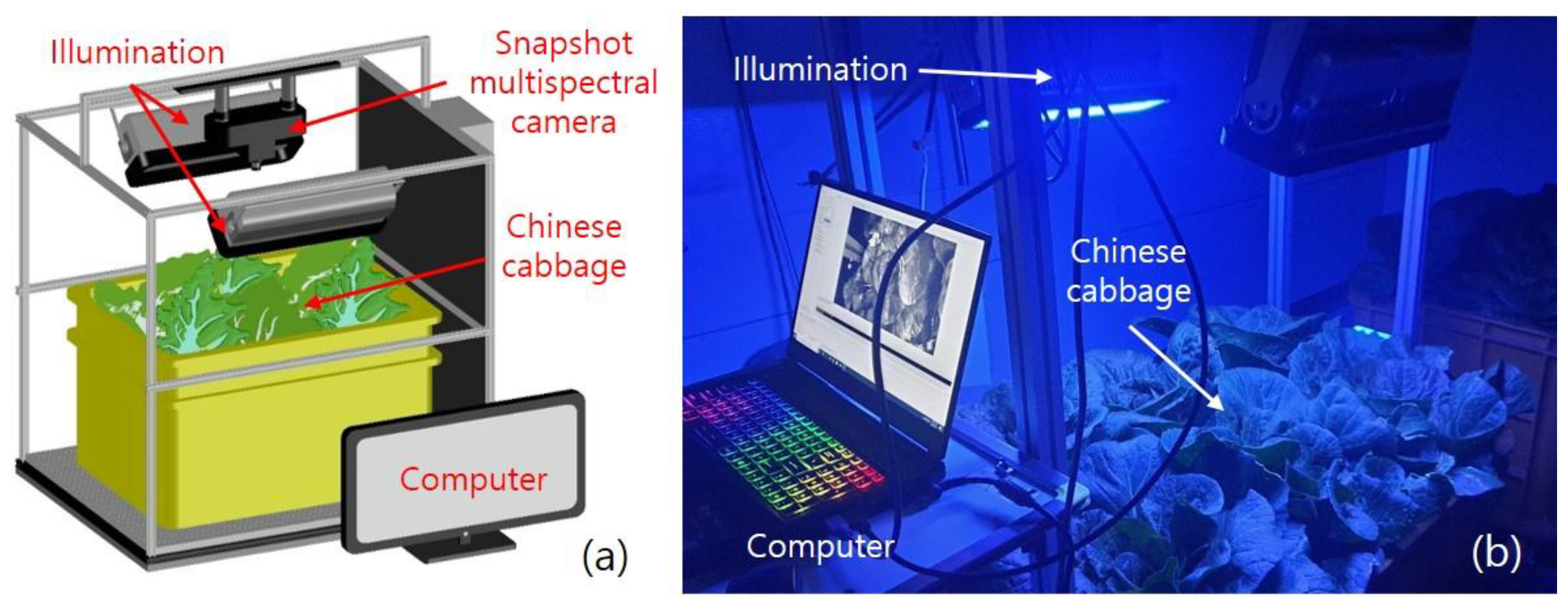
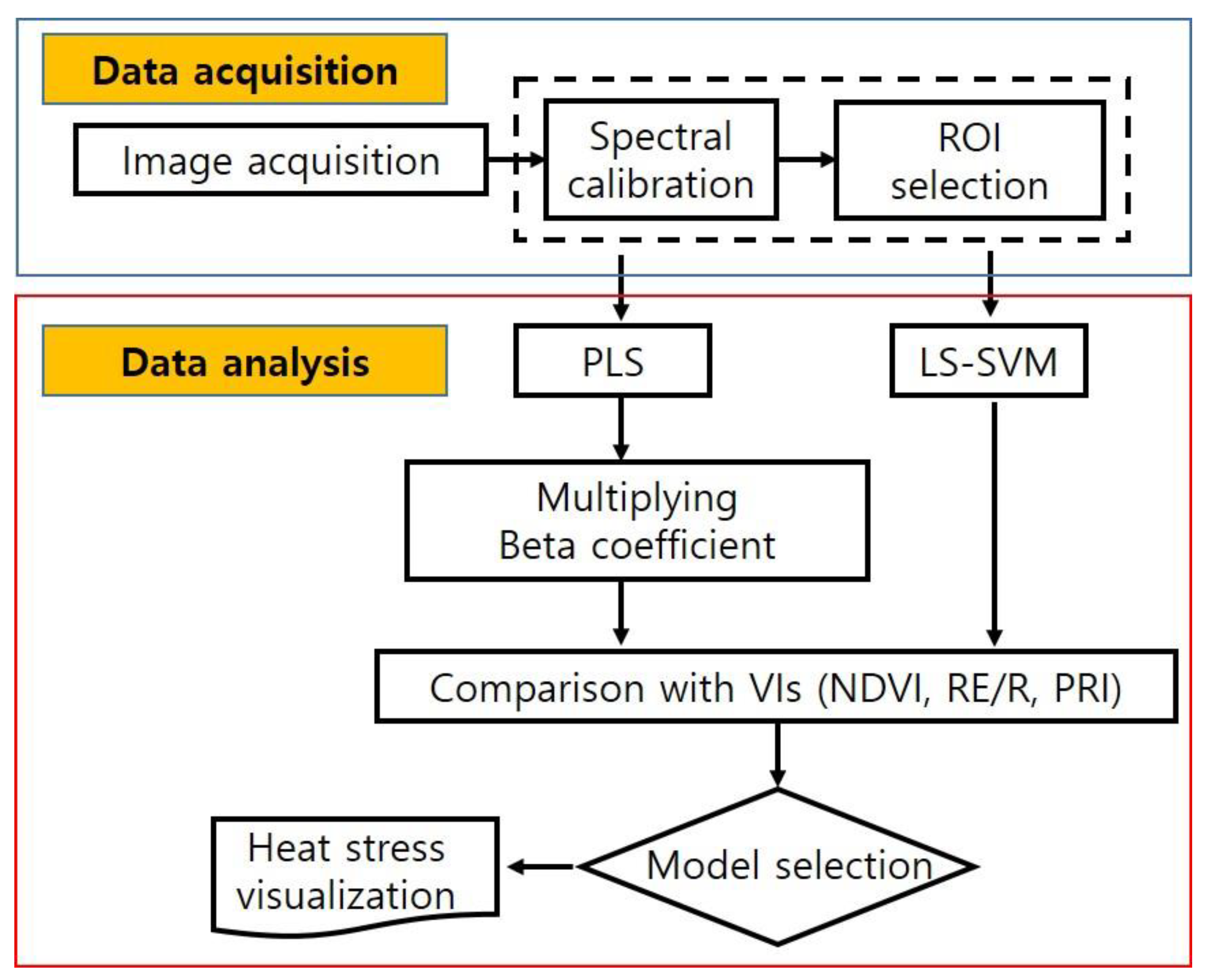
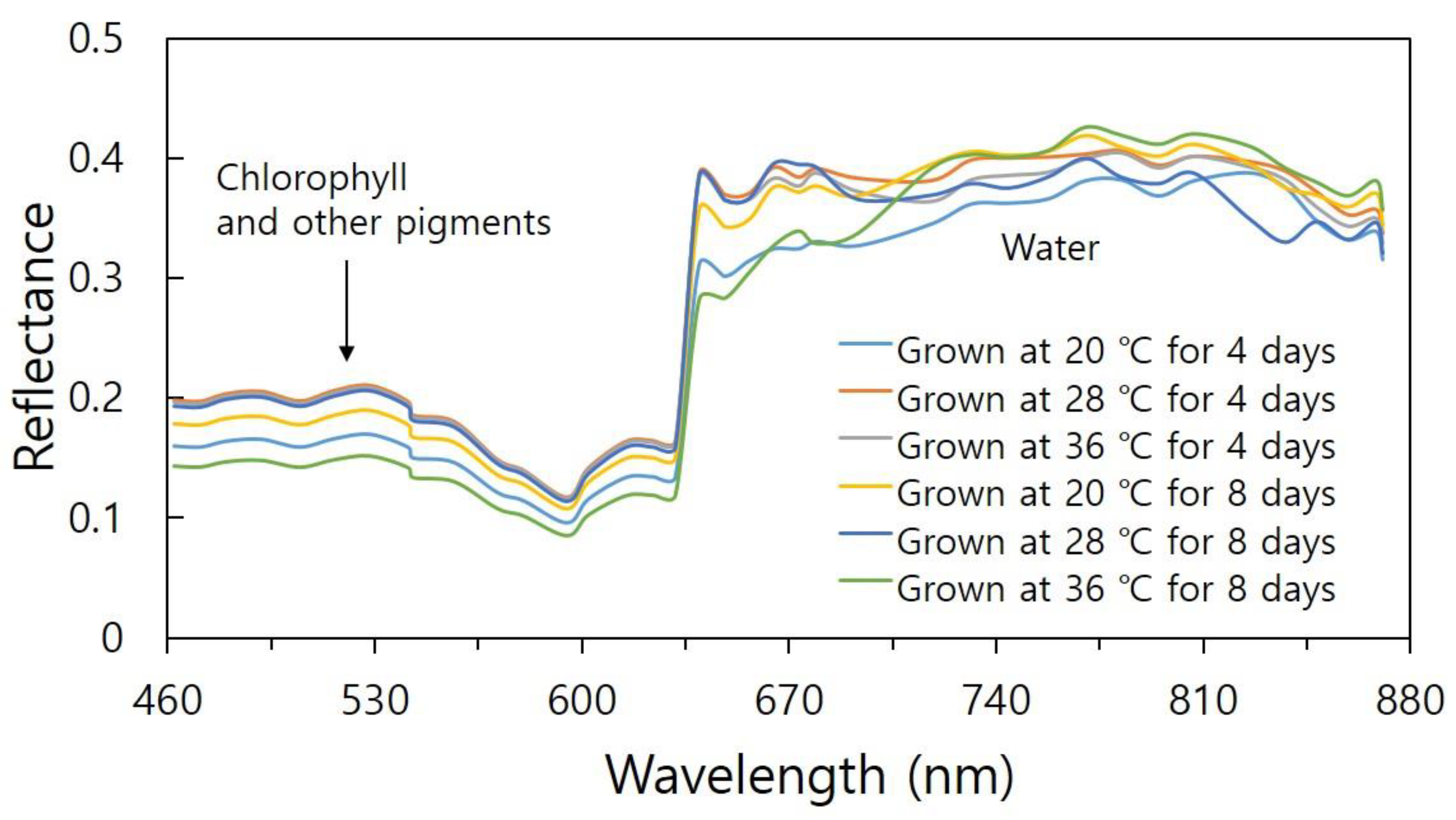
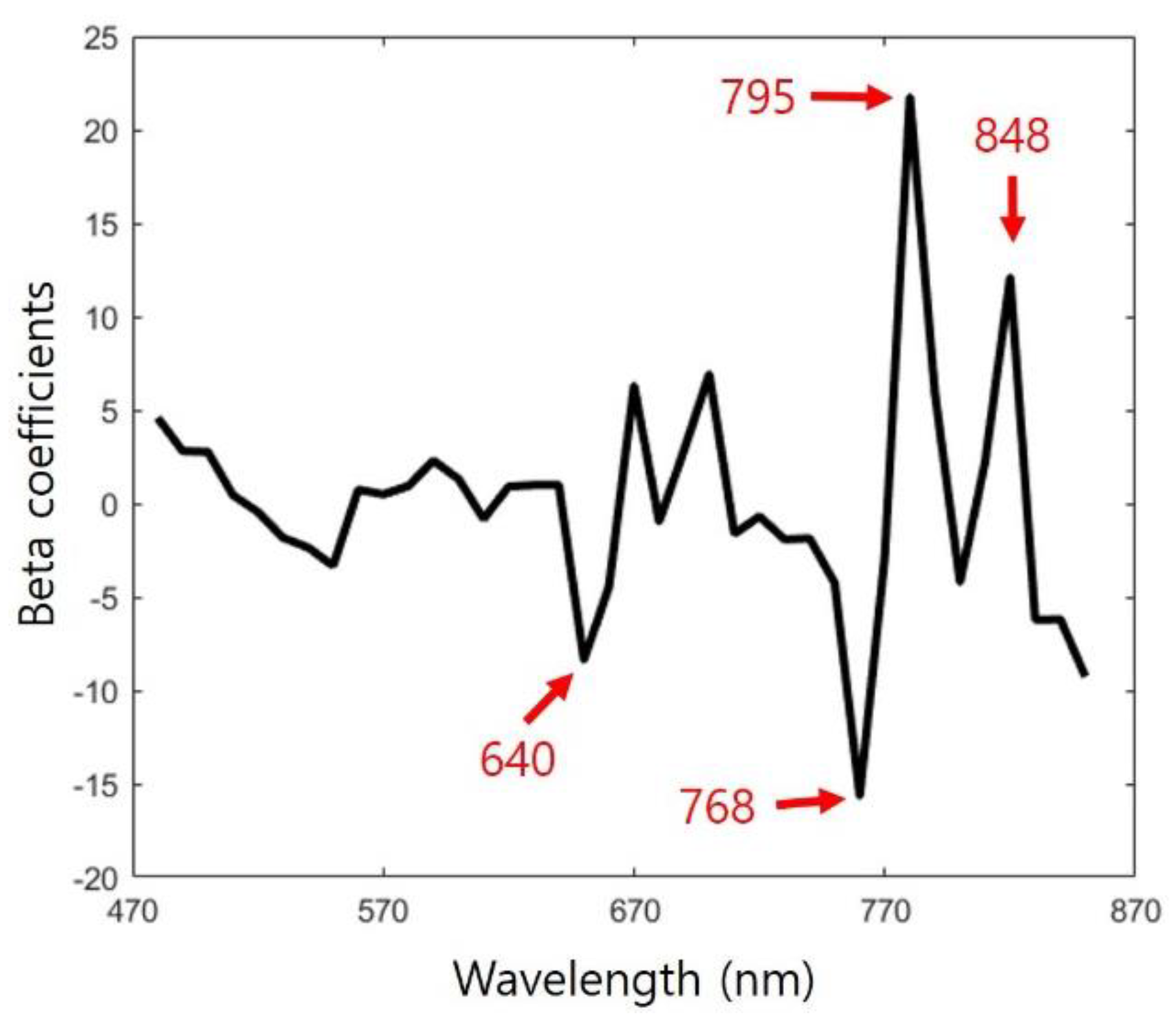
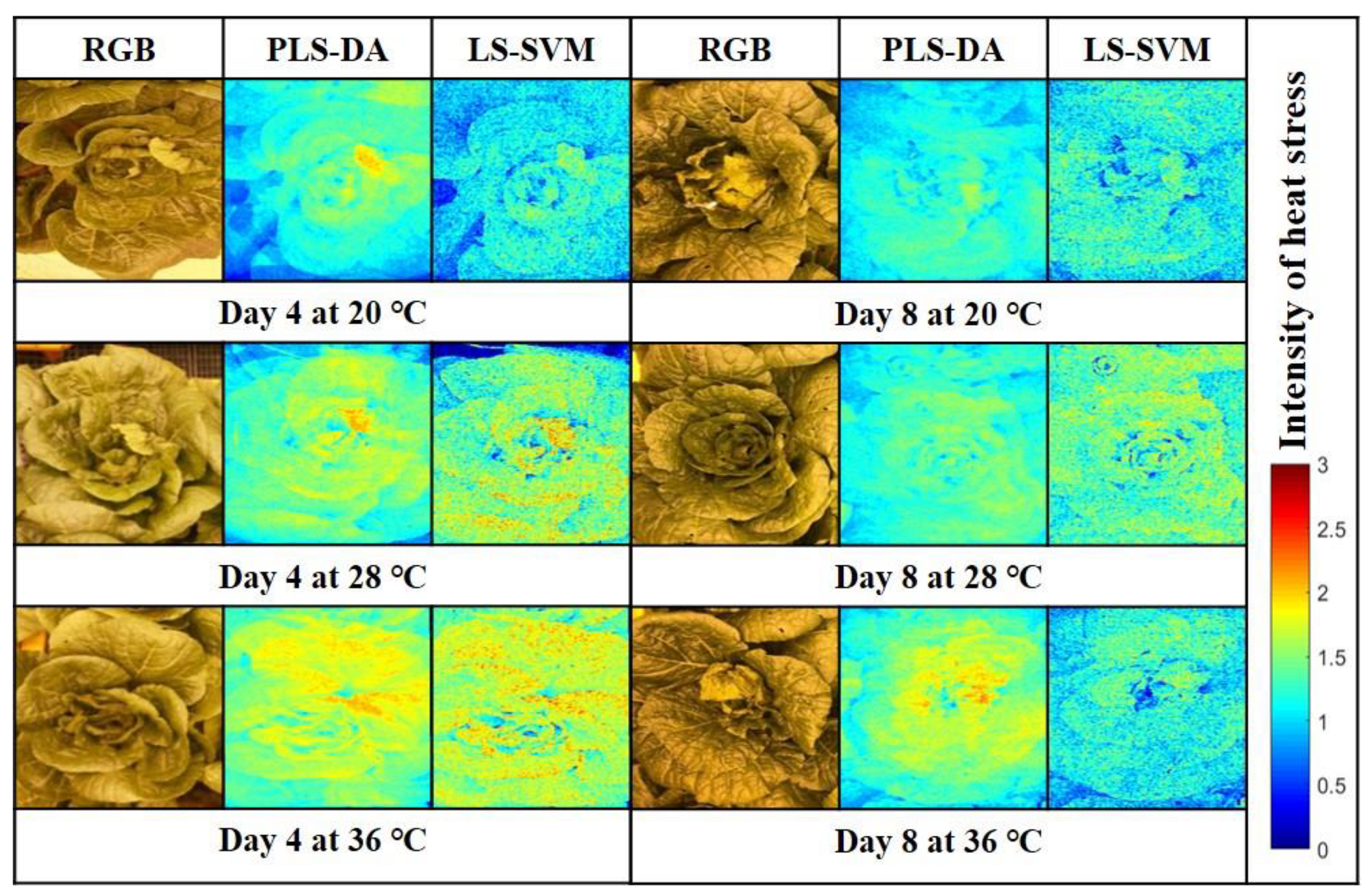
| Temp. (°C) | Fresh Weight (g/Plant) | Dry Weight (g/Plant) | Number of Leaves (/Plant) | Leaf Area (cm2/Plant) | Leaf Length (cm/Plant) | Leaf Width (cm/Plant) |
|---|---|---|---|---|---|---|
| 20/16 | 334.2 NS | 14.8 NS | 47.0 a | 2974 NS | 32.9 NS | 19.0 NS |
| 28/24 | 317.7 NS | 14.7 NS | 42.3 ab | 2925 NS | 32.8 NS | 19.3 NS |
| 36/32 | 300.5 NS | 12.7 NS | 40.7 b | 2857 NS | 32.6 NS | 18.0 NS |
| Temp. (°C) | Vcmax (µmol/m2/s) | Jmax (µmol/m2/s) | TPU (µmol/m2/s) |
|---|---|---|---|
| 20/16 | 181.5 a | 176.0 a | 87.8 b |
| 28/24 | 221.5 a | 211.5 a | 155.9 b |
| 36/32 | 15.4 a | 14.7 a | 11.3 b |
| Group | Day | Temp. (°C) | NDVI | RE/R | PRI | STD 1 of NDVI | STD 1 of RE/R | STD 1 of PRI |
|---|---|---|---|---|---|---|---|---|
| 1 d | 4 | 20 | 0.333 a | 0.382 a | 0.901 a | 0.133 | 0.042 | 0.043 |
| 2 e | 28 | 0.306 b | 0.378 a | 0.916 a | 0.037 | 0.027 | 0.037 | |
| 3 f | 36 | 0.306 b | 0.359 b | 0.899 a | 0.034 | 0.019 | 0.032 | |
| 4 g | 8 | 20 | 0.244 a | 0.499 a | 0.906 a | 0.064 | 0.076 | 0.081 |
| 5 h | 28 | 0.250 a | 0.498 a | 0.909 a | 0.058 | 0.055 | 0.075 | |
| 6 i | 36 | 0.304 b | 0.501 a | 0.897 a | 0.077 | 0.060 | 0.087 |
| Group | Day | Temperature (°C) | Model Accuracy (%) | ||||
|---|---|---|---|---|---|---|---|
| NDVI | RE/R | PRI | PLS-DA | LS-SVM | |||
| A 1 | 4 | 20 vs 28 | 65.3 | 42.8 | 58.1 | 70 | 85.2 |
| B 2 | 28 vs 36 | 72.5 | 62.4 | 48.1 | 75.2 | 87.2 | |
| C 3 | 20 vs 36 | 57.2 | 69.6 | 56.2 | 92.4 | 93.6 | |
| D 4 | 8 | 20 vs 28 | 42.1 | 47.0 | 52.7 | 55.5 | 71.2 |
| E 5 | 28 vs 36 | 71.4 | 55.0 | 51.1 | 75.1 | 82.8 | |
| F 6 | 20 vs 36 | 63.5 | 52.2 | 53.8 | 84.5 | 92.4 | |
Publisher’s Note: MDPI stays neutral with regard to jurisdictional claims in published maps and institutional affiliations. |
© 2022 by the authors. Licensee MDPI, Basel, Switzerland. This article is an open access article distributed under the terms and conditions of the Creative Commons Attribution (CC BY) license (https://creativecommons.org/licenses/by/4.0/).
Share and Cite
Kim, G.; Lee, H.; Wi, S.H.; Cho, B.-K. Snapshot-Based Visible-Near Infrared Multispectral Imaging for Early Screening of Heat Injury during Growth of Chinese Cabbage. Appl. Sci. 2022, 12, 9340. https://doi.org/10.3390/app12189340
Kim G, Lee H, Wi SH, Cho B-K. Snapshot-Based Visible-Near Infrared Multispectral Imaging for Early Screening of Heat Injury during Growth of Chinese Cabbage. Applied Sciences. 2022; 12(18):9340. https://doi.org/10.3390/app12189340
Chicago/Turabian StyleKim, Geonwoo, Hoonsoo Lee, Seung Hwan Wi, and Byoung-Kwan Cho. 2022. "Snapshot-Based Visible-Near Infrared Multispectral Imaging for Early Screening of Heat Injury during Growth of Chinese Cabbage" Applied Sciences 12, no. 18: 9340. https://doi.org/10.3390/app12189340
APA StyleKim, G., Lee, H., Wi, S. H., & Cho, B.-K. (2022). Snapshot-Based Visible-Near Infrared Multispectral Imaging for Early Screening of Heat Injury during Growth of Chinese Cabbage. Applied Sciences, 12(18), 9340. https://doi.org/10.3390/app12189340









